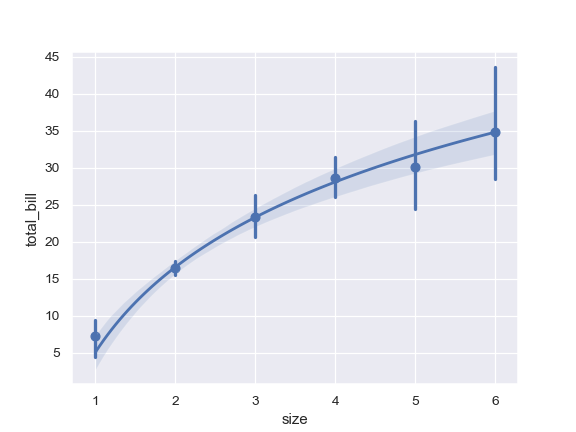seaborn.regplot¶
-
seaborn.regplot(x, y, data=None, x_estimator=None, x_bins=None, x_ci='ci', scatter=True, fit_reg=True, ci=95, n_boot=1000, units=None, order=1, logistic=False, lowess=False, robust=False, logx=False, x_partial=None, y_partial=None, truncate=False, dropna=True, x_jitter=None, y_jitter=None, label=None, color=None, marker='o', scatter_kws=None, line_kws=None, ax=None)¶ Plot data and a linear regression model fit.
There are a number of mutually exclusive options for estimating the regression model. See the tutorial for more information.
Parameters: x, y: string, series, or vector array
Input variables. If strings, these should correspond with column names in
data. When pandas objects are used, axes will be labeled with the series name.data : DataFrame
Tidy (“long-form”) dataframe where each column is a variable and each row is an observation.
x_estimator : callable that maps vector -> scalar, optional
Apply this function to each unique value of
xand plot the resulting estimate. This is useful whenxis a discrete variable. Ifx_ciis given, this estimate will be bootstrapped and a confidence interval will be drawn.x_bins : int or vector, optional
Bin the
xvariable into discrete bins and then estimate the central tendency and a confidence interval. This binning only influences how the scatterplot is drawn; the regression is still fit to the original data. This parameter is interpreted either as the number of evenly-sized (not necessary spaced) bins or the positions of the bin centers. When this parameter is used, it implies that the default ofx_estimatorisnumpy.mean.x_ci : “ci”, “sd”, int in [0, 100] or None, optional
Size of the confidence interval used when plotting a central tendency for discrete values of
x. If"ci", defer to the value of theciparameter. If"sd", skip bootstrapping and show the standard deviation of the observations in each bin.scatter : bool, optional
If
True, draw a scatterplot with the underlying observations (or thex_estimatorvalues).fit_reg : bool, optional
If
True, estimate and plot a regression model relating thexandyvariables.ci : int in [0, 100] or None, optional
Size of the confidence interval for the regression estimate. This will be drawn using translucent bands around the regression line. The confidence interval is estimated using a bootstrap; for large datasets, it may be advisable to avoid that computation by setting this parameter to None.
n_boot : int, optional
Number of bootstrap resamples used to estimate the
ci. The default value attempts to balance time and stability; you may want to increase this value for “final” versions of plots.units : variable name in
data, optionalIf the
xandyobservations are nested within sampling units, those can be specified here. This will be taken into account when computing the confidence intervals by performing a multilevel bootstrap that resamples both units and observations (within unit). This does not otherwise influence how the regression is estimated or drawn.order : int, optional
If
orderis greater than 1, usenumpy.polyfitto estimate a polynomial regression.logistic : bool, optional
If
True, assume thatyis a binary variable and usestatsmodelsto estimate a logistic regression model. Note that this is substantially more computationally intensive than linear regression, so you may wish to decrease the number of bootstrap resamples (n_boot) or setcito None.lowess : bool, optional
If
True, usestatsmodelsto estimate a nonparametric lowess model (locally weighted linear regression). Note that confidence intervals cannot currently be drawn for this kind of model.robust : bool, optional
If
True, usestatsmodelsto estimate a robust regression. This will de-weight outliers. Note that this is substantially more computationally intensive than standard linear regression, so you may wish to decrease the number of bootstrap resamples (n_boot) or setcito None.logx : bool, optional
If
True, estimate a linear regression of the form y ~ log(x), but plot the scatterplot and regression model in the input space. Note thatxmust be positive for this to work.{x,y}_partial : strings in
dataor matricesConfounding variables to regress out of the
xoryvariables before plotting.truncate : bool, optional
By default, the regression line is drawn to fill the x axis limits after the scatterplot is drawn. If
truncateisTrue, it will instead by bounded by the data limits.{x,y}_jitter : floats, optional
Add uniform random noise of this size to either the
xoryvariables. The noise is added to a copy of the data after fitting the regression, and only influences the look of the scatterplot. This can be helpful when plotting variables that take discrete values.label : string
Label to apply to ether the scatterplot or regression line (if
scatterisFalse) for use in a legend.color : matplotlib color
Color to apply to all plot elements; will be superseded by colors passed in
scatter_kwsorline_kws.marker : matplotlib marker code
Marker to use for the scatterplot glyphs.
{scatter,line}_kws : dictionaries
Additional keyword arguments to pass to
plt.scatterandplt.plot.ax : matplotlib Axes, optional
Axes object to draw the plot onto, otherwise uses the current Axes.
Returns: ax : matplotlib Axes
The Axes object containing the plot.
See also
Notes
The
regplot()andlmplot()functions are closely related, but the former is an axes-level function while the latter is a figure-level function that combinesregplot()andFacetGrid.It’s also easy to combine combine
regplot()andJointGridorPairGridthrough thejointplot()andpairplot()functions, although these do not directly accept all ofregplot()’s parameters.Examples
Plot the relationship between two variables in a DataFrame:
>>> import seaborn as sns; sns.set(color_codes=True) >>> tips = sns.load_dataset("tips") >>> ax = sns.regplot(x="total_bill", y="tip", data=tips)
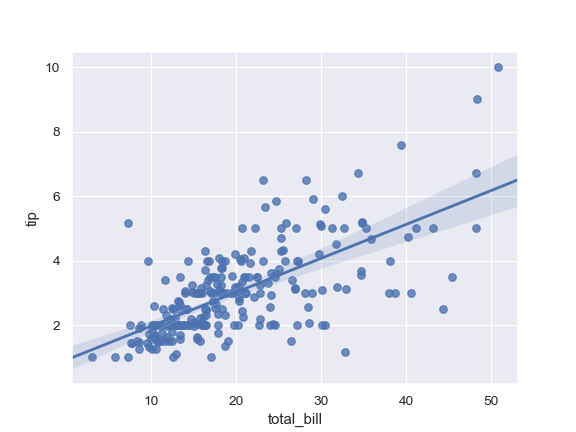
Plot with two variables defined as numpy arrays; use a different color:
>>> import numpy as np; np.random.seed(8) >>> mean, cov = [4, 6], [(1.5, .7), (.7, 1)] >>> x, y = np.random.multivariate_normal(mean, cov, 80).T >>> ax = sns.regplot(x=x, y=y, color="g")
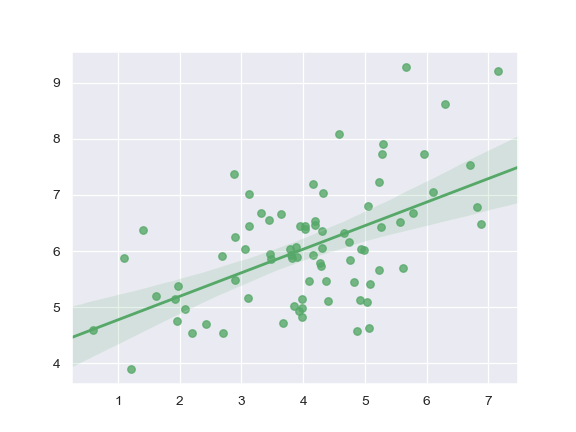
Plot with two variables defined as pandas Series; use a different marker:
>>> import pandas as pd >>> x, y = pd.Series(x, name="x_var"), pd.Series(y, name="y_var") >>> ax = sns.regplot(x=x, y=y, marker="+")
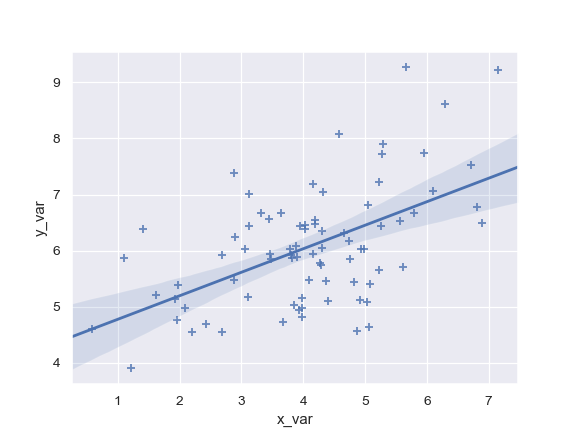
Use a 68% confidence interval, which corresponds with the standard error of the estimate:
>>> ax = sns.regplot(x=x, y=y, ci=68)
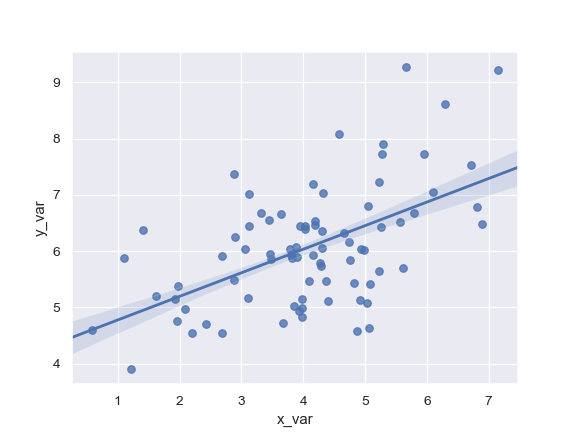
Plot with a discrete
xvariable and add some jitter:>>> ax = sns.regplot(x="size", y="total_bill", data=tips, x_jitter=.1)
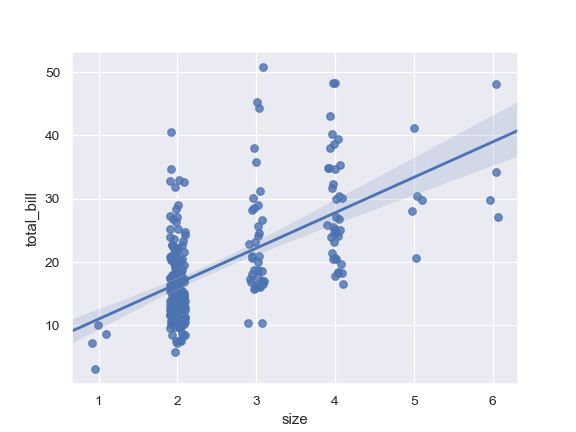
Plot with a discrete
xvariable showing means and confidence intervals for unique values:>>> ax = sns.regplot(x="size", y="total_bill", data=tips, ... x_estimator=np.mean)
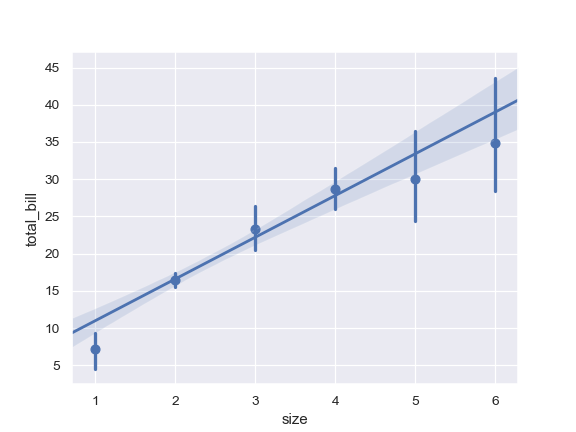
Plot with a continuous variable divided into discrete bins:
>>> ax = sns.regplot(x=x, y=y, x_bins=4)
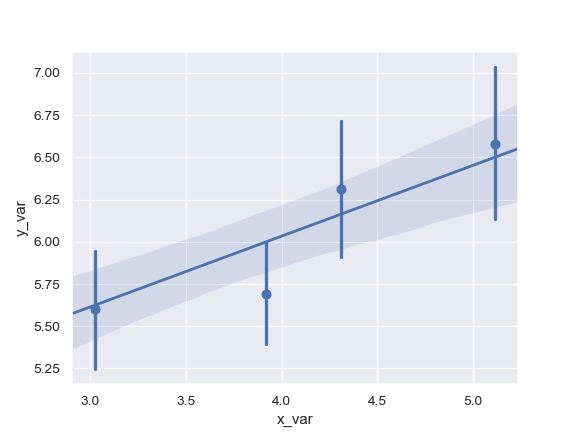
Fit a higher-order polynomial regression and truncate the model prediction:
>>> ans = sns.load_dataset("anscombe") >>> ax = sns.regplot(x="x", y="y", data=ans.loc[ans.dataset == "II"], ... scatter_kws={"s": 80}, ... order=2, ci=None, truncate=True)
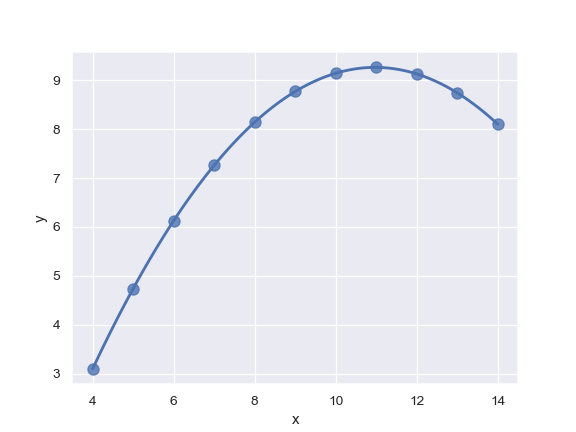
Fit a robust regression and don’t plot a confidence interval:
>>> ax = sns.regplot(x="x", y="y", data=ans.loc[ans.dataset == "III"], ... scatter_kws={"s": 80}, ... robust=True, ci=None)
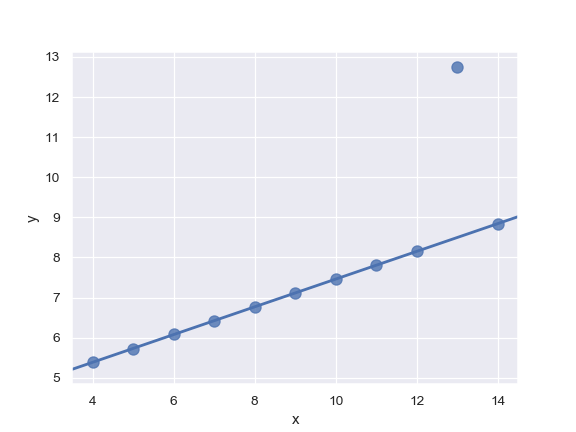
Fit a logistic regression; jitter the y variable and use fewer bootstrap iterations:
>>> tips["big_tip"] = (tips.tip / tips.total_bill) > .175 >>> ax = sns.regplot(x="total_bill", y="big_tip", data=tips, ... logistic=True, n_boot=500, y_jitter=.03)
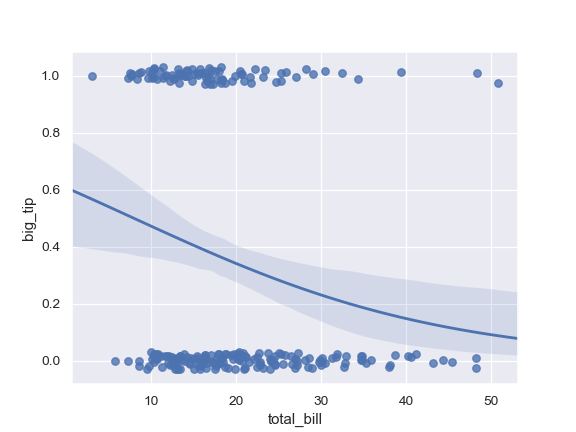
Fit the regression model using log(x) and truncate the model prediction:
>>> ax = sns.regplot(x="size", y="total_bill", data=tips, ... x_estimator=np.mean, logx=True, truncate=True)
